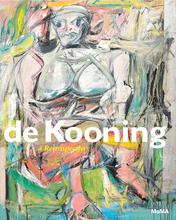More about Composition
- All
- Info
- Shop

Contributor
De Kooning began his career as an illustrator and, like Bailey Doogan, spent much of the rest of his life doing exactly the opposite.
This painting couldn’t sell umbrellas in the rain, I mean, you might ask, what is this painting even of? OK, well firstly it’s not a woman. This was the first thing he painted after his famous “Women” series, so he’s definitely got all the ladies out of his system. Neither is it a landscape; a critic called this a bridge between “Women” and his near-liquid Whose Name Was Writ in Water... If it doesn’t have either nature or women, is it really a painting?
De Kooning had artistic ADD, or you could less-offensively say that he never settled into a rigid style like his peers (looking at you Pollock). Though in fairness a lot of them drank themselves into the grave before they could paint their way out of their ‘style.’ He’s widely quoted as saying, “you have to change to stay the same.” And change he did, from tobacco adverts in the '40s to action painting landscapes in the '80s. In Composition I he’s working his way between styles. There’s a frantic, urban, very New York energy in it—you can almost smell the giant soft pretzels and shawarma over rice. Almost.
De Kooning’s Woman I was controversial, painters and critics felt that he betrayed modernists solemn blood pact against any kind of recognizable content. But once he’d broken that pact he freed himself to do things like Compositon I: loose, vibrant, very much abstract but with a real connection to the physical plane. We’re not looking at astral projections here, this is the lady that released a box of crickets on a subway car, this is cabs not stopping, and neon lights and all that chaotic life stuff. The painting’s biggest claim to fame is not its wall presence, nor its acquisition to a museum’s permanent collection, but that The Daily Beast included it in an “article” celebrating the Guggenheim’s 50th B-day. There you have it, this is the essential de Kooning, according to the cultural arbiters at The Daily Beast.
Sources
- Alsdorf, Bridget. “Willem de Kooning: Composition.” Guggenheim, 2018. Accessed February 23, 2018. https://www.guggenheim.org/artwork/992
- “Biography.” The Willem de Kooning Foundation, 2014. Accessed February 23 2018. http://www.dekooning.org/the-artist/biography
- Haber, John. “Willem de Kooning: An American Master.” haberarts.com: art reviews from around new york, 2018. Accessed February 23, 2018. http://www.haberarts.com/kooning2.htm
- June 9, 2009. “The Guggenheim Turns 50.” The Daily Beast, 2018. Accessed February 23, 2018. https://www.thedailybeast.com/the-guggenheim-turns-50-1
- Stevens, Mark and Annalyn Swan. de Kooning: An American Master. New York: Alfred A. Knopf, 2004. Accessed February 23, 2018. https://books.google.com/books?id=q1NdO1GyagoC&pg=PA184&lpg=PA184&dq=de…












